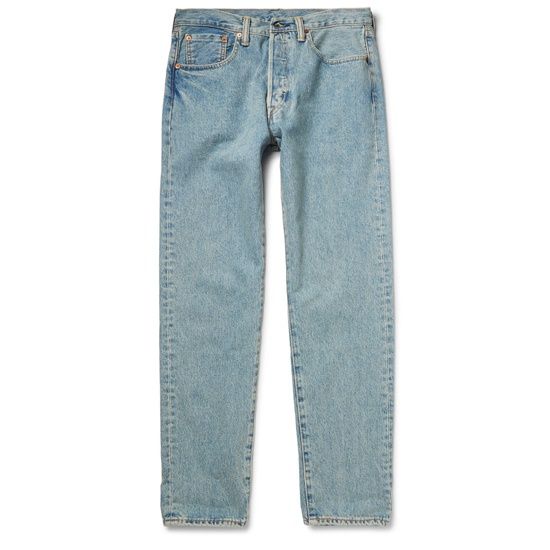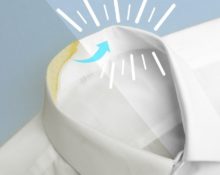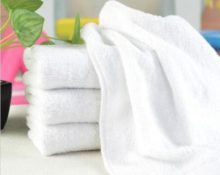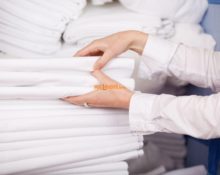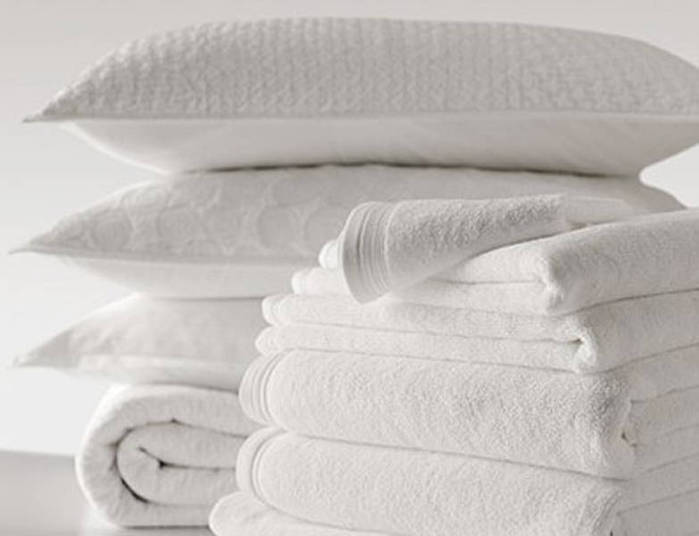The kitchen and bathroom are considered the “face” of the owner of the house. Women who keep order know that even a small trifle can spoil the appearance of a clean room, and very often towels act as such “little things.”
Towels are one of the most frequently used items and that is why they quickly lose their original appearance, especially if they are made of white fabric. Let's find out how to restore the whiteness of kitchen and bath towels.
Features and recommendations for bleaching towels
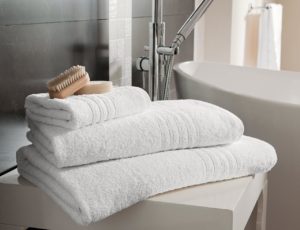 Today, an automatic washing machine can be found in almost every apartment. The unit, which has many functions and capabilities, has greatly simplified people’s lives by washing and bleaching their clothes. You can ensure your white towels are clean and fresh by using each cycle:
Today, an automatic washing machine can be found in almost every apartment. The unit, which has many functions and capabilities, has greatly simplified people’s lives by washing and bleaching their clothes. You can ensure your white towels are clean and fresh by using each cycle:
- stain removers with chlorine, which begin to “work” at 40 degrees;
- oxygen-containing bleaches, which can be used to wash any type of fabric;
- optical means that only color the spots a lighter color.
When choosing the appropriate method for bleaching kitchen or bath textiles, you should consider the following:
- When washing textiles with old stains, it is necessary to soak the fabric for a day in a solution with soda and powder with a bleaching effect, after which it must be washed, dried, and after that, begin removing the remaining stains and bleaching. Before washing, moisten the stains with a mixture of ammonia and glycerin and leave for half an hour.
- When restoring waffle kitchen towels to their original appearance, you need to add a little hydrogen peroxide to the bleaching solution. Soak the fabric in vinegar and leave for half an hour in a plastic bag, then wash as usual.
- To bleach terry, you can use vinegar, which will also soften the fabric. Mix the powder with hair shampoo and laundry soap. Do not use aggressive bleach or alkali.
Important! The key to removing stains and making the fabric white again is to use water hotter than 60 degrees for washing.
The opinion of most housewives agrees that terry cloth is more difficult to wash than regular knitted waffle towels. To avoid problems of this kind, it is better not to use terry napkins in the kitchen.
Important! Wet and dirty terry products are an excellent breeding ground for fungi and other harmful microorganisms. Even before placing in a basket for storing dirty laundry, terry products must be thoroughly dried.
For kitchen hygiene, it is best to use natural linen or cotton.Cellulose or microfiber napkins are also considered a good alternative to textiles used to care for work surfaces and dining tables. However, they, like textiles, must be used according to the rules. Dirty and wet, they can become breeding grounds for dangerous bacteria, just like terry.
How to bleach white towels at home effectively
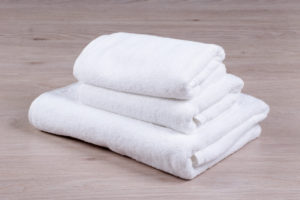 Napkins, large and small white kitchen and bath towels can find a second life if you work a little magic on them. Housewives can take note of the following methods and methods (without boiling):
Napkins, large and small white kitchen and bath towels can find a second life if you work a little magic on them. Housewives can take note of the following methods and methods (without boiling):
- Using laundry soap. The fabric is soaped before the main wash and left for 30 minutes. The washed and dry linen or terry product is left overnight in a container with potassium permanganate and small pieces of soap diluted in hot water (in the morning the textiles should be washed as usual).
- “Knocking out a wedge” using vegetable (store-bought) oil. Add oil (20ml), soda (30g), powder (50g), bleach to boiling water (10l) and place dry towels there (do not reach until the water cools, then wash as usual). Sunflower oil should be added only after the powder and bleach have dissolved in boiling water. IN hot water (5 l) to which powder has been added, bleach (2 l) and oil (3 l) are placed on dirty towels for several hours, after which they are washed as usual.
- Mustard as a means for bleaching any type of fabric (suitable for colored items). Rub a solution of mustard (10g) and water onto the contaminated areas and leave for 2 hours, then wash as usual.Dirty items are placed in the prepared (strained) mixture of boiling water (2 cups) and mustard (50g), which has been infused for 2 hours, for 3 hours, which are then washed at 70 degrees.
- Using soda and salt. Before the main wash, items can be soaked in a solution of salt (3 tbsp) and cold water. It is recommended to soak towels that have turned a little yellow overnight in a solution of peroxide, water (5l), powder and salt (5k1). Small stains can be lightly wiped with salt and peroxide mixed with water.
- Use of manganese. Potassium permanganate, which has bleaching and disinfecting properties, is dissolved in water (3 crystals per 1 liter of water) into which the contaminated item is placed overnight. Rub a mixture of manganese (10 drops of a solution prepared according to the recipe described above), laundry soap (1 tablespoon) and hot water on the stain and leave for several hours, after which the item is washed as usual in a machine.
Important! Manganese crystals should only be dissolved in glass containers. It will stain plastic and enamel.
The above methods fall into the category of time-tested methods for whitening towels. Thanks to the development of technology, another method has emerged, which is considered one of the fastest and most effective - the method of bleaching in microwave ovens. Wet medium-sized knitted or terry towels rubbed with laundry soap are placed in a plastic bag, which is placed in the microwave. The power is set to maximum, the time is set to 2 minutes. There is no need to be afraid that the fabric can be damaged in this way; the waves do not destroy its structure. The package is not tied.
How to bleach waffle towels
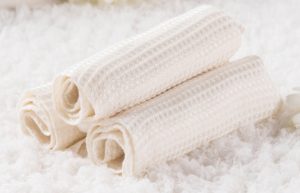 Because cotton waffle fabric absorbs dirt much better, they are much easier to wash. Hydrogen peroxide and acetic acid are best suited for bleaching this type of textile:
Because cotton waffle fabric absorbs dirt much better, they are much easier to wash. Hydrogen peroxide and acetic acid are best suited for bleaching this type of textile:
- towels are soaked in pure peroxide or its aqueous solution and left for 40 minutes;
- After this, the fabric is rinsed in plenty of cold water and washed by hand.
Acetic acid is used only on washed waffle towels. The fabric is completely saturated with an aqueous acid solution and left for half an hour. After this, the bleached product is washed in a machine on a double rinse with citric acid.
How to bleach old kitchen towels
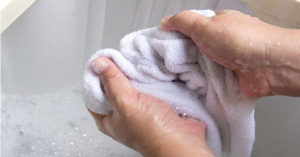 It may take much longer for old napkins to return to their original appearance. One of the most effective ways to save such things is boiling. To prepare a solution for digestion you will need:
It may take much longer for old napkins to return to their original appearance. One of the most effective ways to save such things is boiling. To prepare a solution for digestion you will need:
- silicate glue – 2 tbsp;
- water – 5 l;
- crushed laundry soap - 2 tbsp.
The boiling time should not exceed 30 minutes. After the procedure, towels should be rinsed in cold water and machine washed as usual.
Products made from natural fabrics (linen and cotton) can be boiled in white water. In addition to the fact that whiteness can restore cleanliness to fabrics, it also disinfects them. For the solution you will need:
- white – 3 tbsp;
- liquid powder (dishwashing liquid) – 6 tbsp;
- water – 9 l.
The ingredients are mixed in an enameled or galvanized container (basin, saucepan), dipped towels into the solution and set to boil. Boiling time – no more than 20 minutes. After things have cooled down, they need to be rinsed thoroughly, changing the water 2-3 times.
Important! Children's towels should not be boiled in chlorine-containing products.
Recommendations for keeping towels white
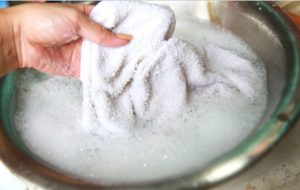 In order not to think about methods of bleaching towels, you need to know the secrets of proper handling of this type of textile product:
In order not to think about methods of bleaching towels, you need to know the secrets of proper handling of this type of textile product:
- Having bought a new towel, you need to carefully study its tag, which indicates the acceptable washing methods;
- White must be washed separately from colored;
- hard water needs to be softened;
- Using a delicate washing mode will help protect the delicate structure of terry fabrics from deformation;
- Terry should not be dried near heating devices;
- If a stain appears on a white towel, it must be washed immediately, not allowing it to dry out;
- You need to change kitchen towels every 3-4 days.
Proper care of household textiles will not only help preserve them in their original form for a long time, but will also help protect against many diseases caused by bacteria multiplying in the fabric.


 0
0